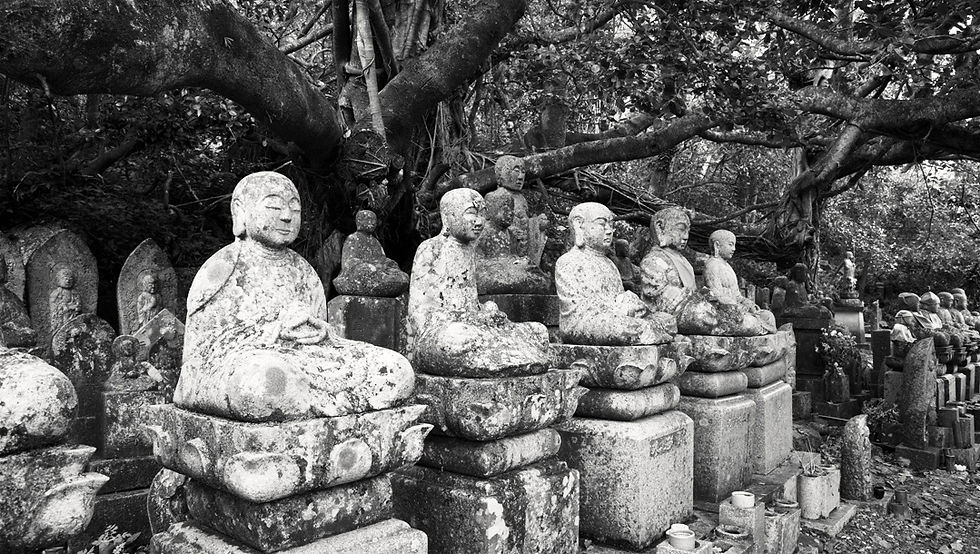Japan: Ojizo Sama, Protectors and Guides for Lost Souls
- Olivier
- Apr 14, 2023
- 13 min read
Updated: Mar 15
Ojizo Sama are revered Buddhist figures, particularly known for their role as protectors of children, travelers, and troubled souls. These statues, often recognizable by their childlike appearance, are omnipresent in Buddhist temples, along roadsides, in cemeteries, and in the mountains throughout the country.
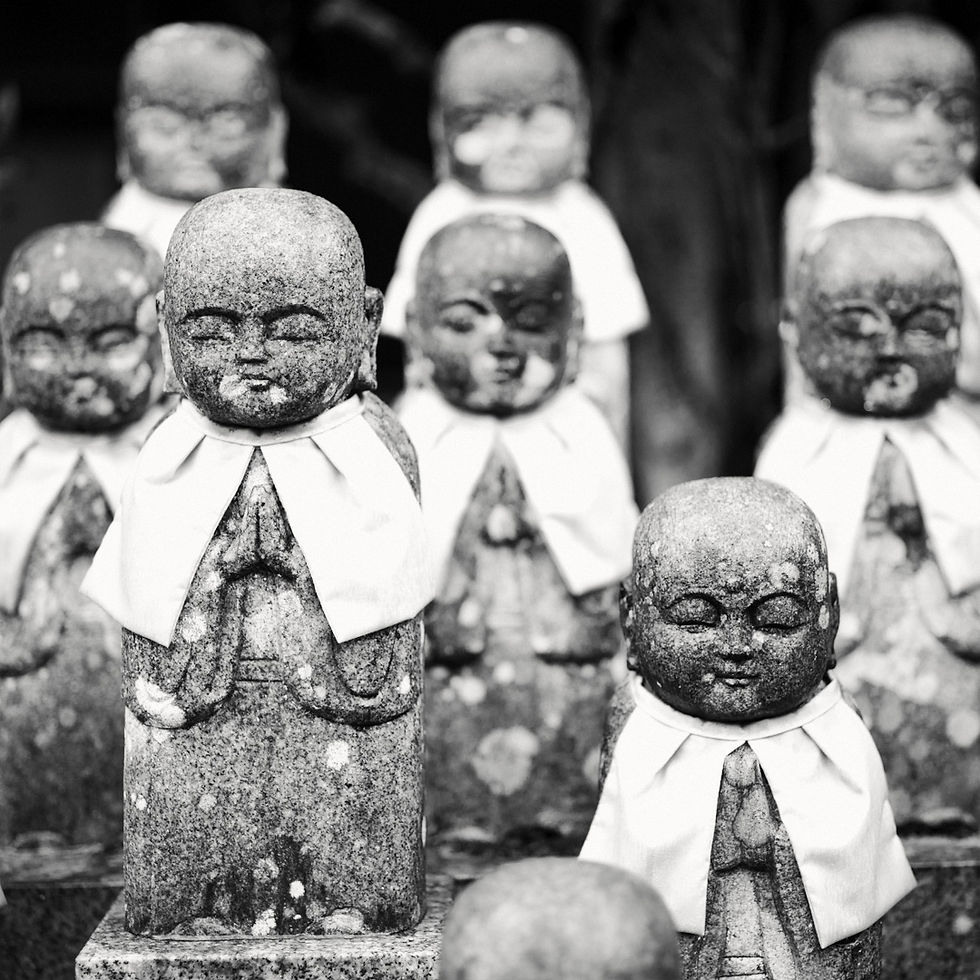
They represent a millennia-old tradition of compassion, hope, and protection in Japanese Buddhism. Their origins, rooted in Mahayana Buddhism, have evolved to meet the needs and beliefs of Japanese society over the centuries.
Even today, Jizo remain a powerful symbol of the connection between the living and the dead, between the everyday and the sacred, and they continue to perpetuate a rich and meaningful spiritual heritage recognized by all.
Jizo or Ojizo Sama
As is often the case in the Japanese language, words and names of people are accompanied by various honorifics. The term "San" is perhaps the most commonly used, indicating respect towards another person when mentioning them in conversation or text.
The term "Sama" is a more elaborate version of this honorific, used for people or objects with historical or spiritual significance. In the case of Jizo, who embody a sacred Buddhist representation, it is not uncommon to refer to them as Jizo Sama. In this context, to further emphasize respect, the letter "O" is often prefixed to the name.
However, in everyday language, they are often called Jizo or Jizo San. This is not a sign of disrespect but rather a verbal simplification. For the sake of simplicity in writing this article, I will refer to them as Jizo.
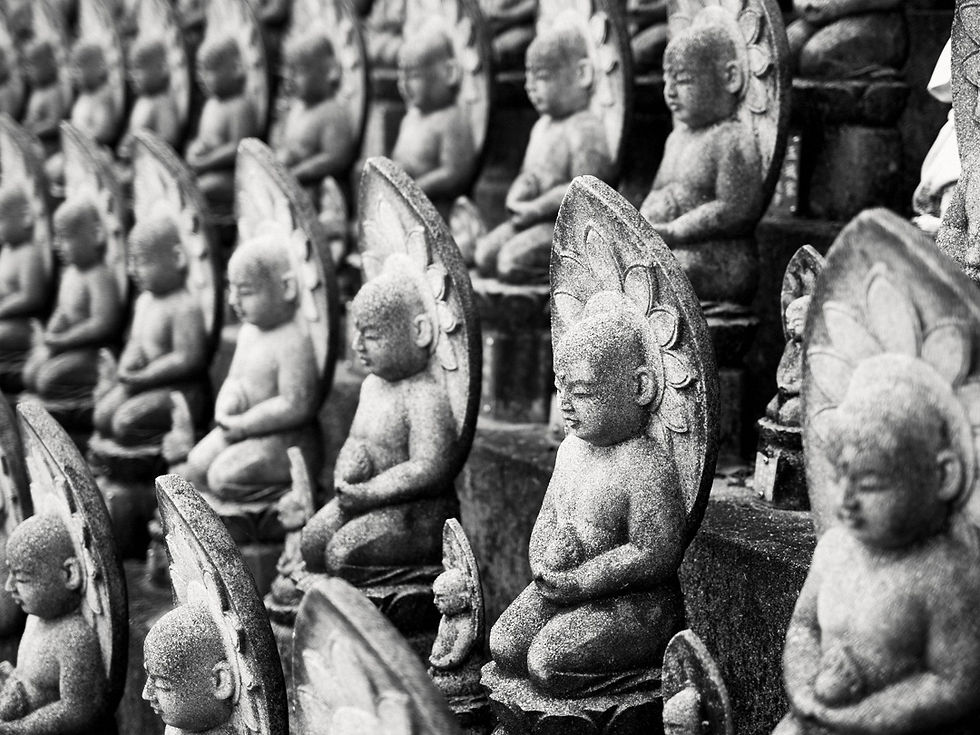
Contents:
Origins of Jizo and Introduction to Japan
Jizo originate from the bodhisattva Ksitigarbha, a major figure in Mahayana Buddhism. The name "Ksitigarbha" translates to "Earth Treasury," reflecting his role as the protector of living beings and lost souls.
According to Buddhist texts, Ksitigarbha vowed not to attain enlightenment (Nirvana) until all beings were saved from the cycle of rebirth (samsara). Ksitigarbha is known by different names across Asia, including Jizo (地蔵) in Japan, Dizang (地藏) in China, and Địa Tạng in Vietnam.
Buddhism was introduced to Japan in the 6th century, brought by missionaries from China and Korea. Along with it, the figure of Ksitigarbha was also introduced. However, it was during the Heian period (794-1185) that Ksitigarbha began to gain particular significance in Japan, gradually becoming known as Jizo (地蔵). His worship adapted to local Japanese beliefs, complementing Shinto, Japan's indigenous religion, and taking on unique characteristics that distinguish him from Dizang, his Chinese counterpart.
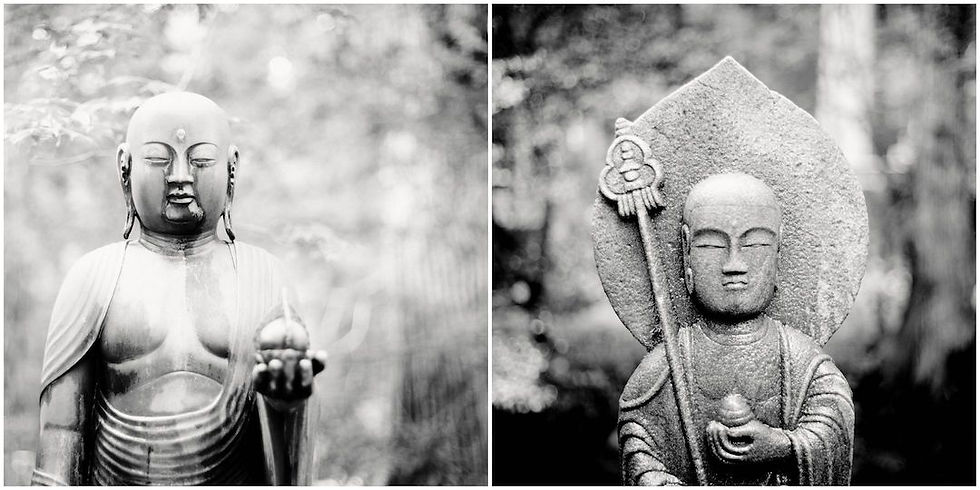
Evolution and Popularization
During the Kamakura period (1185-1333), Japan experienced a time of social and political upheaval. Pure Land Buddhism (Jōdo-shū) and the teachings of the monk Hōnen spread widely, emphasizing the salvation of the soul through faith in Amida Buddha.
It was during this time that Jizo began to be revered not only as a guide for souls in the afterlife but also as a protector against earthly suffering, particularly for children, pregnant women, and travelers. This role of Jizo solidified during the Muromachi period (1336-1573) and the Edo period (1603-1868), when his worship became even more popular.
The worship of Jizo saw significant expansion during the Edo period, a time marked by relative stability and rapid population growth. This period witnessed an increase in popular beliefs regarding the protection of children, especially due to the high rate of infant mortality. Jizo then became known as the protector of the souls of deceased children, particularly those who died before or shortly after birth, referred to as "Mizuko" (水子).
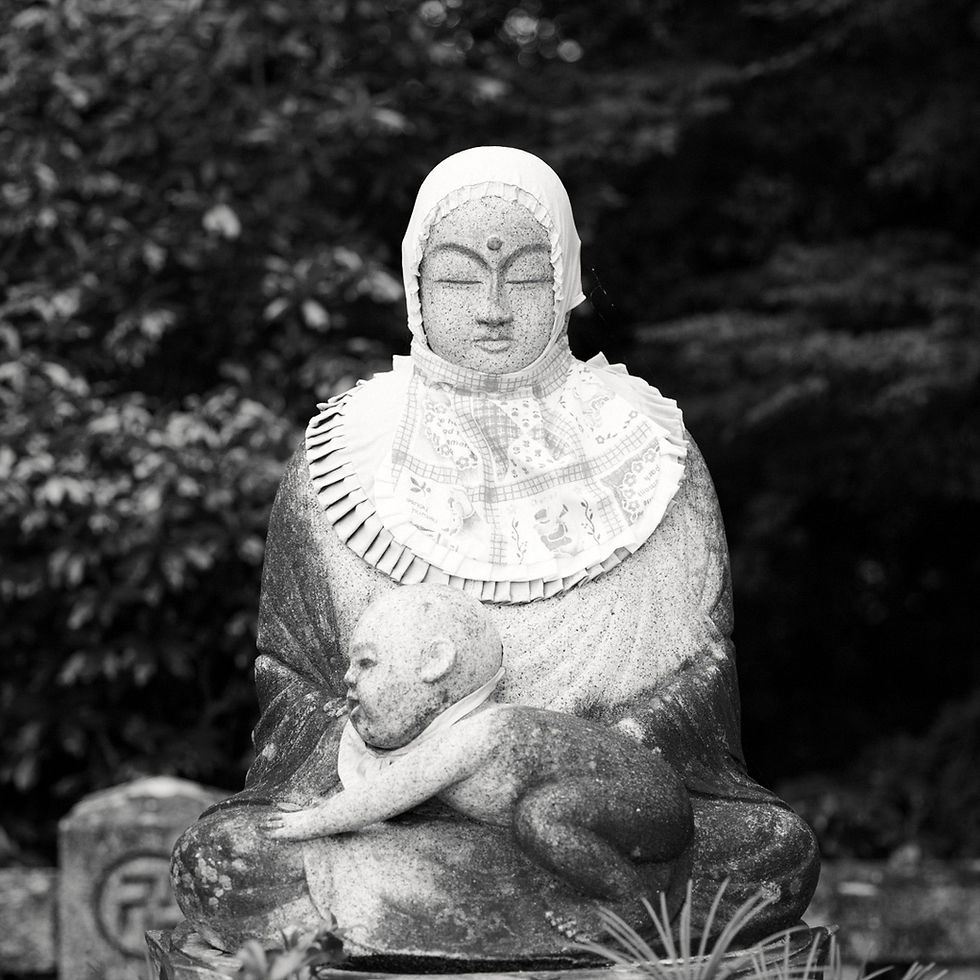
Role in Contemporary Japanese Society
In modern Japan, Jizo is primarily associated with funerary rites for children, notably the "Mizuko kuyō" (水子供養), ceremonies intended to soothe the souls of stillborn, aborted, or young deceased children.
These ceremonies particularly developed from the 1970s onward, coinciding with an increase in abortions related to urbanization and the transition to a more industrialized society. Parents, often burdened by guilt or grief, turn to Jizo to protect and guide their child's soul in the afterlife.
The Jizo statues found in temples or public spaces are often dressed in bibs or red hats, symbols of protection and kindness. In Japan, the color red is traditionally associated with protection against illness and evil spirits. Parents also place toys or small food offerings at the base of these statues, praying for the well-being of their children, whether living or deceased.
Distribution and Representation
Jizo statues vary widely in size and shape, but they generally share certain characteristics. Jizo is often depicted as a monk, with a shaved head, wearing a simple Buddhist robe, and holding a "Shakujo" (錫杖), a pilgrim's staff adorned with metal rings. This staff is intended to signal his presence and ward off malevolent spirits along his path. In his other hand, he typically holds a jewel called "Hoju" (宝珠), which grants wishes and symbolizes wisdom (see photo below).
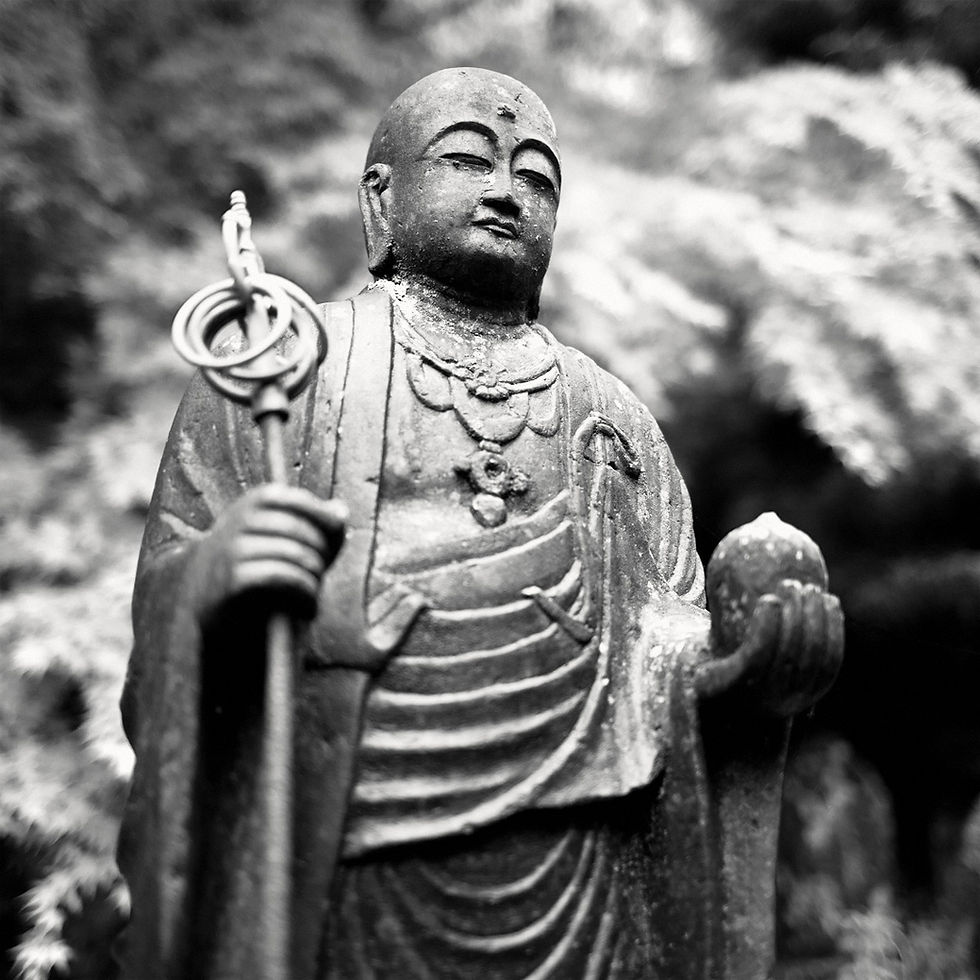
Jizo are particularly numerous in some famous temples, where thousands of small statues are lined up, each representing a Mizuko. These statues are continually replenished by families who come to honor the memory of their children.
Famous Temples for Their Jizo Collections
Several temples in Japan are renowned for their collections of Jizo statues, each with particular significance and attracting visitors for spiritual, cultural, or historical reasons. Here are some of the most well-known temples:
Zojo-ji (増上寺) in Tokyo
Located in Minato, near the famous Tokyo Tower, Zojo-ji is a significant Buddhist temple of the Jōdo sect. It is especially known for its collection of "Sentai Jizo" (千躰地蔵), or "thousand Jizo," where rows of small Jizo statues are lined up, often adorned with red hats and bibs. These statues are erected in memory of Mizuko (children who died prematurely) and are continuously maintained and replenished by grieving families.
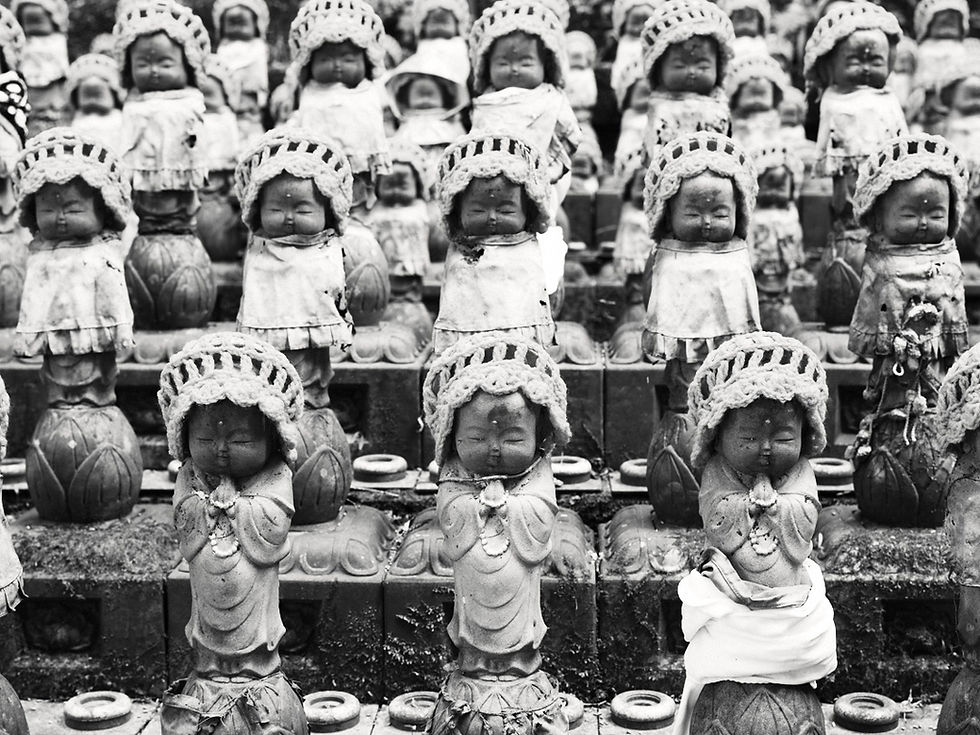
© O. Robert
Hasedera (長谷寺) in Kamakura
Hasedera, also known as Hase Kannon, is a Jōdo sect temple in Kamakura. In addition to its famous statue of Kannon, the temple has a large collection of small Jizo statues. These Jizo are often placed by visitors in memory of their deceased children, particularly in a specific area dedicated to Jizo Bosatsu.
Rokuharamitsu-ji (六波羅蜜寺) in Kyoto
This Kyoto temple, founded in the 10th century, is known for housing a particularly venerated statue of Jizo Bosatsu. Rokuharamitsu-ji is linked to the history of ancient Japan and has long been a place of devotion for those seeking Jizo's protection. The temple is also famous for its Jizo statues placed in various locations throughout the grounds.
Sanjusangendo (三十三間堂) in Kyoto
Although this temple is most famous for its 1,001 statues of Kannon, it also houses a significant collection of Jizo statues. Sanjusangendo, a Tendai sect temple, is a place where believers come to pray for protection and healing. Jizo plays a central role here for those seeking spiritual comfort.
Jizo-in (地蔵院) in Kyoto
Known as "Take no Tera" or "Bamboo Temple," Jizo-in is a small temple located near the bamboo grove of Arashiyama in Kyoto. The temple is particularly peaceful and features many Jizo statues scattered throughout its garden. Visitors come here to meditate and pray, surrounded by the tranquility of the forest.
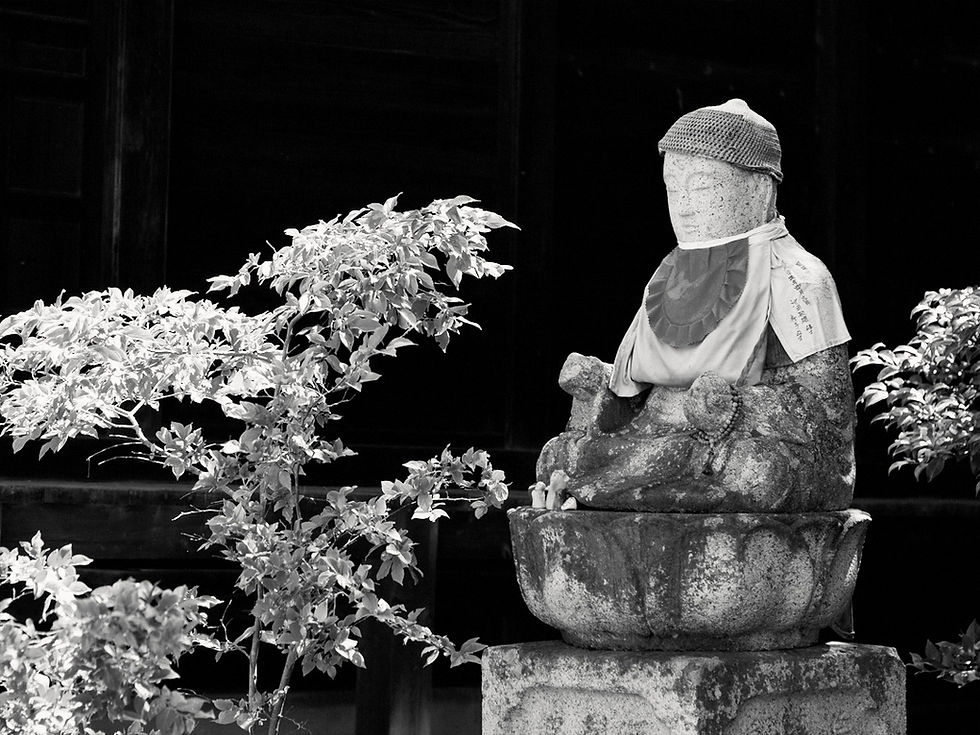
Zoji-ji (草津地蔵寺) in Kusatsu, Shiga
This temple is another important site for the veneration of Jizo. It is known for its large Jizo statues, which attract many pilgrims. Zoji-ji is distinguished by its rituals related to the protection of children and travelers.
Otagi Nenbutsu-ji (愛宕念仏寺) in Kyoto
Located in the mountains north of Kyoto, this temple is a lesser-known but fascinating site due to its thousands of "Rakan" (disciples of Buddha) and Jizo statues. Each statue has a unique expression, and the temple is a place of devotion where visitors can experience a strong spiritual connection with the figures they see.
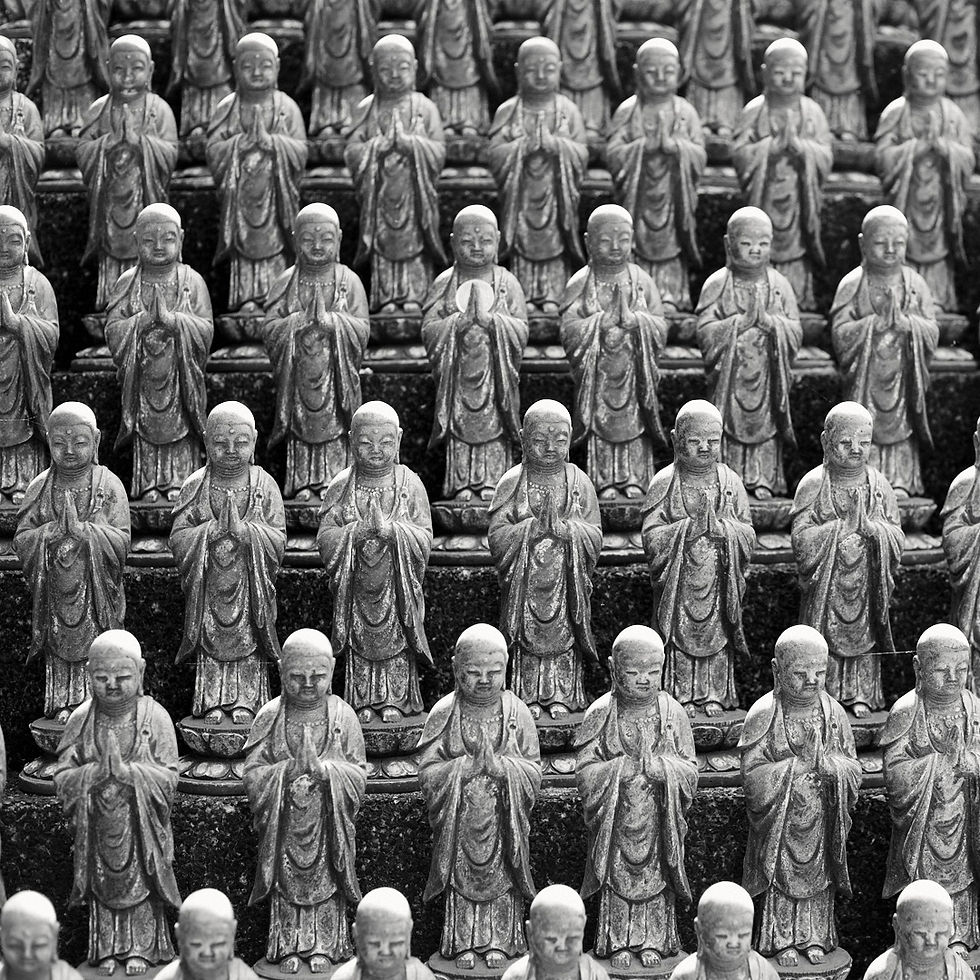
The Henro Pilgrimage of the 88 Temples Around Shikoku Island
Jizo at these temples play an important role as protectors of the pilgrims undertaking this challenging journey. They represent compassion and kindness, essential qualities for those embarking on this path, which, beyond its physical challenge, is profoundly introspective and spiritual.
Speaking of a pilgrimage I know particularly well, having completed it twice over 6 years, here are some examples of temples that are also significant for their collections of Jizo. If you wish to learn more about this photographic experience at these 88 temples, you can read my articles dedicated to them here.
Temple 6: Anraku-ji (安楽寺)
Anraku-ji is a temple where pilgrims often pray for safety during their journey. The temple has several Jizo statues, which are considered protectors of travelers. Pilgrims turn to Jizo to seek protection throughout their pilgrimage on Shikoku Island.
Temple 10: Kirihata-ji (切幡寺)
Kirihata-ji, located on a steep hill, is known for its statue of Jizo Bosatsu. Pilgrims pray here for healing and protection against illnesses, especially those affecting children. The Jizo statues at the temple are revered for their protective and healing powers.

Temple 12: Shōsan-ji (焼山寺)
Shōsan-ji is one of the most difficult temples to access on the pilgrimage due to its mountainous location. Also known as "the Burnt Temple," it is associated with spiritual trials, and the Jizo statues here are venerated for their assistance in times of difficulty. Pilgrims pray at this temple for the strength and perseverance needed to continue their journey.
Temple 21: Tairyu-ji (太龍寺)
Tairyu-ji, located at the top of a mountain and accessible by either a cable car or a challenging hiking trail, houses several Jizo statues. This temple is a place of prayer for the protection of children and travelers. Pilgrims turn to Jizo here for help during moments of doubt or fatigue throughout the pilgrimage.
Temple 25: Shinshō-ji (津照寺)
Shinshō-ji, located near the coast, is also known for its Jizo statues. Pilgrims come here to pray for safety at sea, and Jizo is venerated as a protector of fishermen and sailors. This temple serves as a reminder of the dangers of travel, whether by land or sea.
Temple 51: Ishite-ji (石手寺)
Ishite-ji, located near Matsuyama, is one of the most important and mysterious temples on the Shikoku pilgrimage. This temple houses a wide variety of Jizo statues scattered across its expansive grounds. Pilgrims pray to Jizo here for various reasons, including the protection of children and good fortune. Ishite-ji is also famous for its cave, which represents the different stages of the path to enlightenment, where Jizo statues play a symbolic role as spiritual guides.

Temple 58: Senyū-ji (仙遊寺)
Senyū-ji, perched on a mountain, is known for its peaceful atmosphere and numerous Jizo statues. It is a place where pilgrims can rest and reflect, with the Jizo here venerated for offering protection and comfort throughout the journey.
Temple 75: Zentsū-ji (善通寺)
Zentsū-ji is one of the most important temples on the pilgrimage, as it is the birthplace of Kōbō Daishi (also known as Kukai, the founder of Shingon Buddhism). This temple also houses several Jizo statues, and pilgrims come here to pray for health and protection, following the example of Kōbō Daishi's compassion.
Temple 80: Kokubun-ji (国分寺)
Kokubun-ji, a state temple established by Emperor Shōmu, also features Jizo statues that are venerated for their protective power. Pilgrims pray here for inner peace and safety as they approach the end of their pilgrimage.
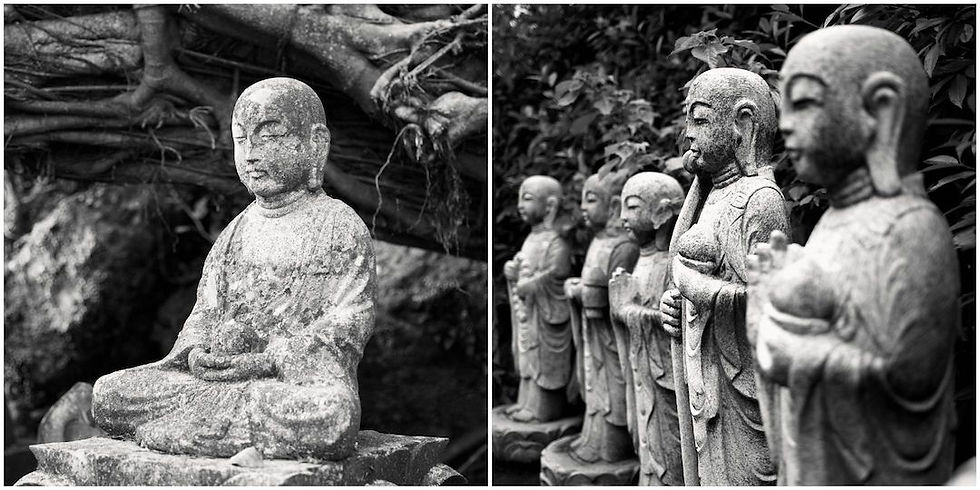
Key Figures and Legends
The veneration of Jizo is also enriched by numerous popular legends. One of the most famous is the story of "Sai no Kawara" (賽の河原), a mythical riverside in the afterlife where the souls of children who died prematurely are said to build stone piles in an attempt to reach heaven. According to the legend, these piles are constantly destroyed by demons, but Jizo intervenes to protect the children, hiding some under his robe and helping them rebuild the stone piles.
Another important story is that of "Jizo Bosatsu" and the monk "Ennin" (794-864), an influential religious figure from the Heian period who is believed to have spread the devotion to Jizo in Japan after his pilgrimage to China. Ennin's accounts describe Jizo as a powerful intercessor, capable of saving souls from the torments of hell.
Symbolism and Spiritual Significance
Beyond his specific role as a protector of children, Jizo embodies universal compassion in Japanese Buddhism. He is regarded as the "savior of the six realms" (Rokudo), which are the six planes of existence according to Buddhist teachings:
The hells (Jigokudo)
The realm of hungry spirits (Gakido)
The animal realm (Chikushodo)
The realm of Asura, the fighting spirits (Shurado)
The human realm (Jindo)
The realm of gods (Tendo)
Jizo, through his commitment to saving all suffering beings, represents the Buddhist principle of bodhicitta, the vow of every bodhisattva to attain enlightenment for the benefit of all beings.
Jizo's role has also expanded to that of a protector of travelers. Due to this association, Jizo statues are often found along roads, pilgrimage paths, and in the mountains, where travelers pray for a safe journey.
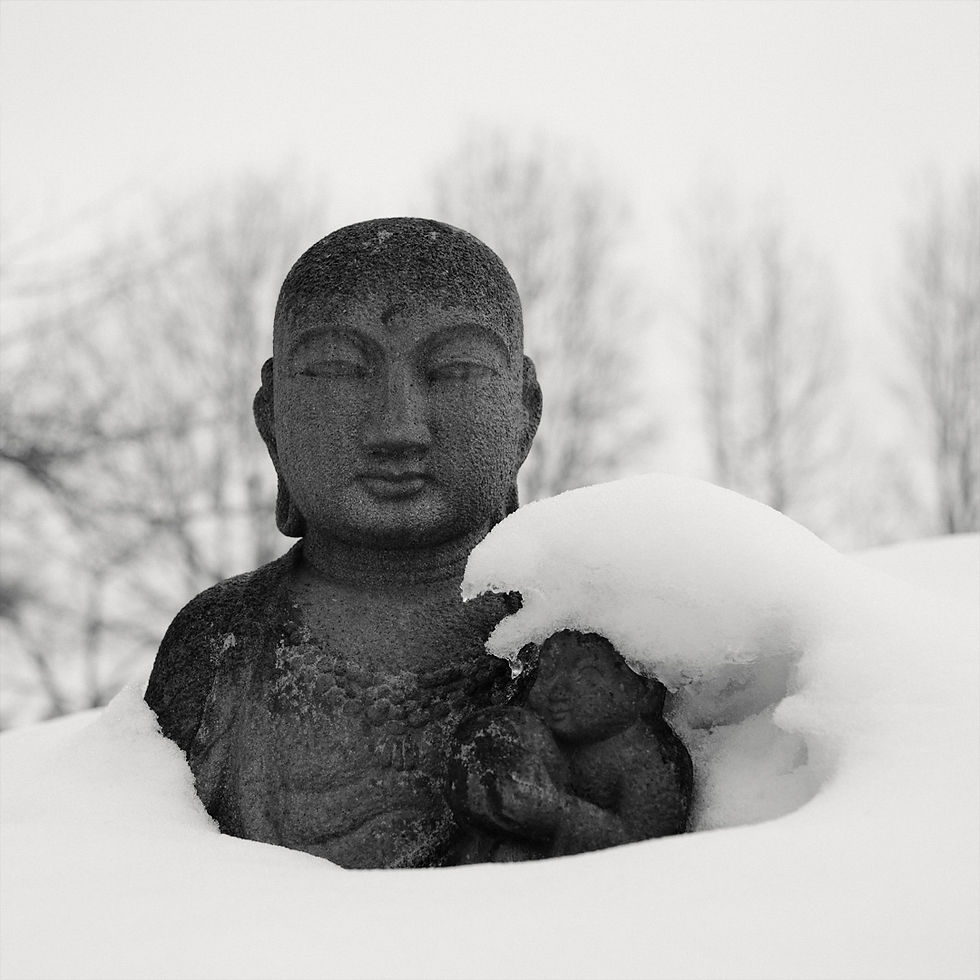
Cultural and Artistic Impact
Jizo's presence in Japanese culture extends beyond temples and funerary rites; he also holds a significant place in art and literature. Depictions of Jizo are common in woodblock prints, where he is often portrayed in scenes of daily life or landscapes. Popular arts, such as *Netsuke* (small wooden ornaments), embroidered kimonos, and scroll paintings, also incorporate the figure of Jizo.
In literature, Jizo appears in various folktales and legends, as well as in modern works where he symbolizes protection and compassion. His presence is also felt in Japanese cinema, particularly in films that explore themes of the afterlife or complex family relationships.
Permanence and Misappropriations
Despite the rapid changes in Japanese society over recent decades, particularly in terms of family and religious values, the veneration of Jizo remains strong. Temples continue to hold ceremonies for Mizuko, and Jizo statues are still erected by individuals or communities, especially during times of mourning or after collective tragedies, such as natural disasters.
However, some critics have pointed out the risk of commercialization within the Jizo cult, particularly through the sale of statuettes and paid religious services in certain temples. Despite this, the figure of Jizo retains deep emotional and spiritual significance for many people in Japan, underscoring his enduring role as a protector and guide in a constantly changing world.
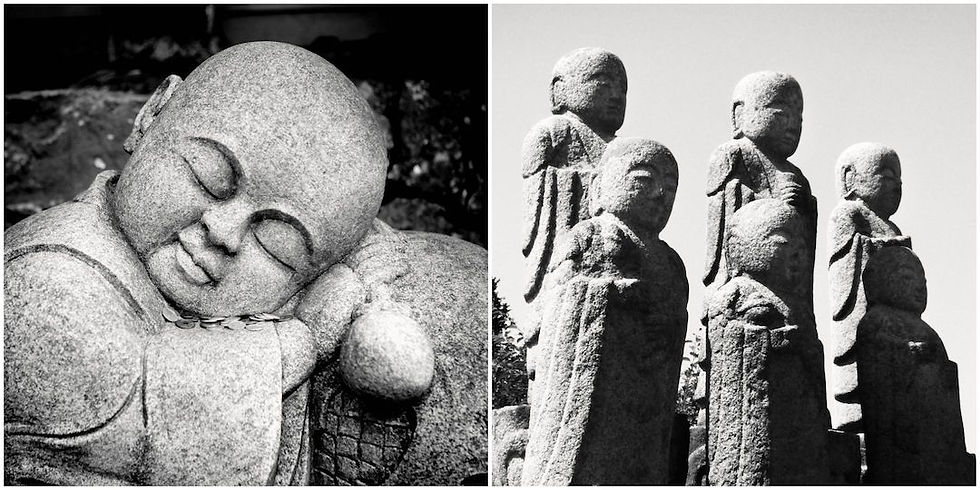
Jizo and Photography
The figure of Jizo embodies profound compassion and a commitment to protecting the vulnerable, whether they are children, wandering souls, or travelers. In Japanese Buddhism, Jizo symbolizes a promise of unwavering comfort and support, transcending the boundaries of life and death. He represents a spirituality that, despite its religious origins, touches the universal by offering a model of unconditional kindness.
Photography, as an art form, shares a similar mission: to capture and convey emotions, states of mind, and fleeting moments with a depth that resonates beyond the image itself. Like Jizo, the photographer becomes a guardian of moments of fragility, beauty, or suffering, and is entrusted with an ethical and aesthetic responsibility. Each click of the camera is an invitation to observe the world with respect and attentiveness, to capture reality while honoring the dignity of the subjects photographed.
Respect, in this context, becomes an essential value. Photography is not merely a technical act; it is an act of communion with the subject, a tribute to life as it presents itself, in its complexity and simplicity. Like Jizo, the photographer must embody through their images a form of protection: the protection of authenticity, emotion, and the integrity of the captured moments.
Thus, photography becomes a spiritual bridge, a vehicle of emotions that, like Jizo, transcends the boundaries of time and space. It demands from the artist a particular sensitivity, a deep respect for what is immortalized, transforming each image into a visual offering to memory and humanity.
